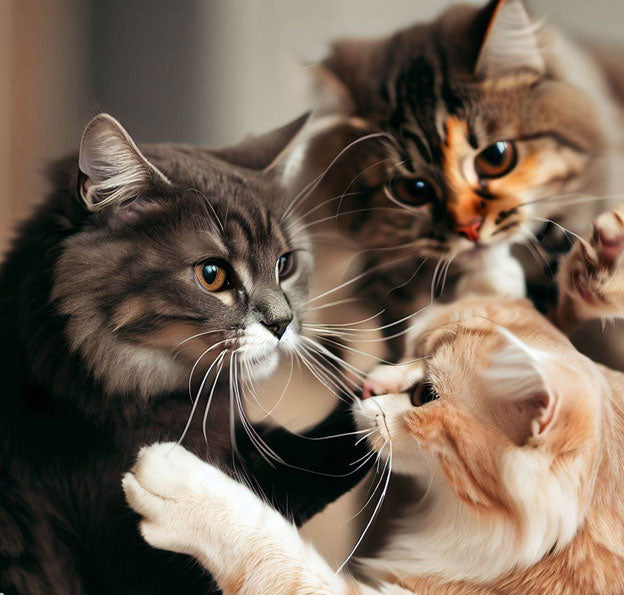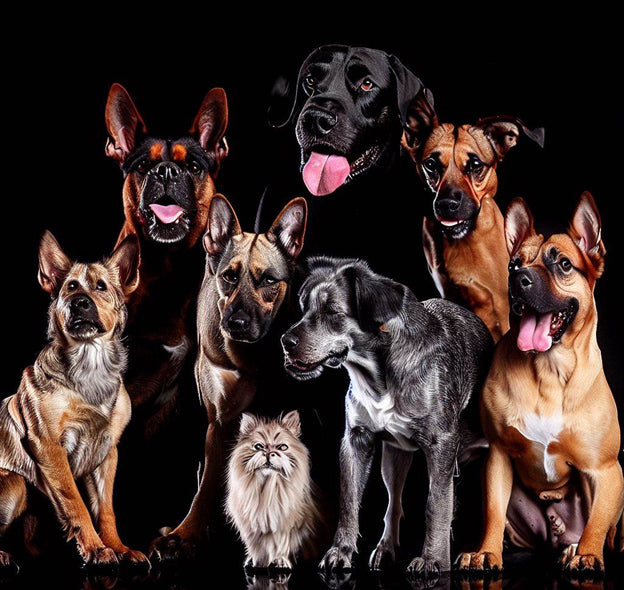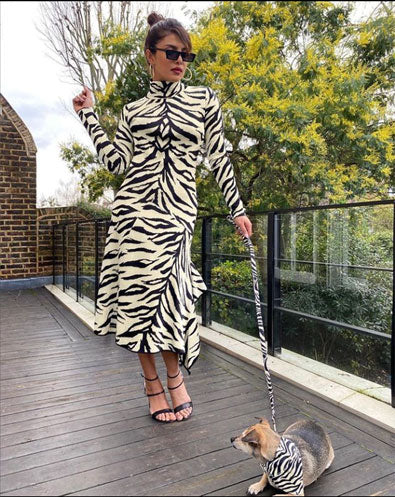
How to Know if My Cat and Dog Are Playing or Fighting?
Disclaimer: Some of the links in our blog posts are affiliate links. This means we may earn a small commission if you make a purchase through them which helps support our blog, at no extra cost to you.
The expression "fighting like cats and dogs" is one we've all heard, and it does hold true at times. However, there are also instances of cats and dogs that get along and become friends. You may find your cat and dog playing together harmoniously.
On the other hand, it might be your dog attempting to show affection by licking your cat. What do these interactions mean, and why do some cats and dogs struggle to get along? Why do dogs and cats fight at times? No need to worry; we have the answers to ensure your dog and cat can be friends and coexist peacefully. Learn about the dynamics of dog and cat playing together, their friendly and sometimes rough play, and how to manage situations like a cat hissing at a dog. We'll explore why dogs and cats might only sometimes get along.
Why Do Dogs and Cats Fight?
Dogs and cats may fight for various reasons, and understanding these factors can help prevent conflicts and promote peaceful coexistence. Here are some common reasons why dogs and cats might fight:
1. Territorial Disputes: Both dogs and cats can become aggressive if they feel their space is being invaded, especially when introducing a new pet to the household.
2. Fear or Anxiety: Fear and anxiety can trigger defensive behaviors in dogs and cats. If one animal is scared or feels threatened, they may react aggressively to protect themselves.
3. Predatory Instincts: Cats have strong predatory instincts, and their sudden movements or stalking behavior can trigger a dog's prey drive, leading to aggressive behavior. Dogs may chase cats as they perceive them as prey.
4. Miscommunication: Cats and dogs have different communication styles. What may be playful or friendly behavior for one species could be perceived as a threat by the other. Misunderstandings in body language and vocalizations can lead to fights.
5. Resource Guarding: Dogs and cats may fight over valuable resources like food, toys, or your attention. Animals may become possessive and protective of these resources.
6. Lack of Socialization: Proper socialization during a pet's early developmental stages is crucial. If dogs and cats are not exposed to each other and other animals during this time, they may have difficulty interacting positively.
7. Past Trauma: Previous negative experiences with the other species can lead to fear or aggression. For example, a cat once scratched by a dog may react aggressively when encountering another cat.
8. Health Issues: Pain or discomfort can make pets irritable and more prone to aggressive behavior. If one of your pets is unwell, they might react aggressively if approached by the other.
9. Predominance of One Species: In some cases, a household may have more dominance from one species, causing the other to feel threatened or subordinate.
Proper introductions, socialization, and ongoing supervision are important to prevent fights and foster a peaceful environment between dogs and cats. Training and positive reinforcement can help modify behavior, and consulting with a veterinarian or animal behaviorist may be necessary in more challenging cases.
Are My Cat and Dog Playing or Fighting: How to Know the Difference
Distinguishing between play and actual fighting between your cat and dog can ensure both pets' safety and well-being. Here are some key indicators to help you differentiate between the two:
| Attribute |
Play |
Fight |
|
Body Language |
During play, both the cat and dog typically exhibit relaxed and loose body language. Their tails may be up or wagging gently, and their ears are often neutral or slightly forward. Play usually involves pouncing, chasing, and mock wrestling. |
Both animals tend to have tense and stiff body language in a fight. Their tails may be puffed up (especially for cats), and their ears may be pinned back or flattened against their heads. Growling, hissing, or barking are common during a fight. |
|
Vocalizations |
Vocalizations during play are usually cheerful and non-threatening. You may hear soft barks, chirps, or meows that indicate excitement rather than aggression. |
Aggressive vocalizations during a fight are more intense and threatening. Growls, hisses, and aggressive barking are common signs of a fight. |
|
Biting |
Playful biting typically involves gentle nips and mouthing. The bites are inhibited, and neither pet appears distressed. You may notice them taking turns in being the "chaser" and the "chasee." |
Aggressive biting is forceful and often results in injury or distress. The bites may be accompanied by attempts to pin or dominate the other pet. |
|
Pauses |
During play, the cat and dog should take brief breaks, pause the activity, and even groom themselves or each other. These breaks show that they are comfortable with the interaction. |
There are typically no breaks or pauses in a fight, and the conflict may escalate if left unchecked. |
|
Tail Movements |
Tails may wag or twitch during play, but it's usually not violent or aggressive. The tail movements are often loose and playful. |
Aggressive tail movements may involve a puffed-up tail (for cats) or a stiff, raised tail (for dogs). |
The line between play and fighting can sometimes be blurry, and each pet's personality and relationship dynamics can influence the interpretation of their behavior. Always monitor their interactions closely, especially during initial introductions, and intervene if you're unsure or if play escalates into aggression. Gradual socialization and positive reinforcement can help ensure a harmonious coexistence between your cat and dog.
Dogs and cats playing rough can sometimes blur the line between friendship and conflict in their interactions. Pet owners want to avoid cat and dog fighting, as it can be stressful for both animals. The scenario of a cat hissing at a dog signals the feline's discomfort. However, dog and cat friends can often surprise us with their deep bond, displaying their affection in various ways. It's heartwarming to see cats and dogs harmonizing and sharing their living space easily.
How to Encourage Cat and Dog Friendship
Encouraging a harmonious relationship between your dog and cat, where they can enjoy dog and cat playing together and become actual dog and cat friends rather than escalating into dog and cat fighting, involves several strategies:
-
Gradual Introductions: Start with controlled introductions, allowing your cat and dog to get used to each other's presence without direct interaction. Use a baby gate or separate rooms to create a safe barrier.
-
Positive Associations: Use treats, praise, and rewards to associate each other's presence with positive experiences. For example, reward the dog and cat with treats for playing or calm behavior to create positive associations.
-
Supervised Interactions: Gradually progress to supervised interactions, where you can observe their behavior closely. Be ready to intervene if the dog and cat playing turns too rough.
-
Separate Safe Spaces: Ensure each pet has its own space, such as a crate for the dog and a quiet room for the cat, where it can retreat when it needs a break.
-
Obedience Training: Teach your dog basic commands like "sit" and "stay." This can help control their impulses during dog and cat playing and prevent overexcitement.
-
Desensitization: Gradually expose both pets to each other's scents by swapping bedding or toys. This helps them become accustomed to each other's presence.
-
Routine and Predictability: Establish a feeding, walking, and playtime routine. Predictable patterns can reduce anxiety and tension in both pets.
-
Cat-Friendly Retreats: Create elevated spaces and hiding spots for your cat to observe the dog without feeling threatened. Cats often appreciate vertical space.
-
Positive Reinforcement: Continue to reward and praise both pets when they exhibit calm and friendly behavior while the dogs and cats play.
-
Patience and Time: Building a strong friendship between a dog and a cat can take time, so be patient and persistent. Every small step towards cats and dogs that get along is a step in the right direction.
By following these strategies, you can encourage a positive and lasting bond between your dog and cat, fostering a relationship where they enjoy dog and cat playing together and becoming true dog and cat friends.
If you own a dog and a cat owns you, you might enjoy custom pet gifts where you can have movie-inspired pet portraits. You can also print pictures of your cat or dog on mugs, phone cases, blankets, and pillows. You can also give them to fellow cat and dog parents.
Popular Blog
7 Unique Products That Every Dog Owner Will Love
Let’s be honest, our dogs run the house. They make us laugh, steal our socks,...
50 Funny Dog Birthday Puns for a Tail-Wagging Good Time!
Here is a delightful collection of 50 dog birthday puns guaranteed to bring s...
Homemade Dog Toys Your Pooch Will Love: Top 10 DIY Delights
Pet toys, especially safe dog toys, can be expensive and don’t last too long....
Canine Companions Worldwide: Modern Treatment & Taxes for Dog Owners
The intricate relationship between humans and dogs is a testament to a profou...











